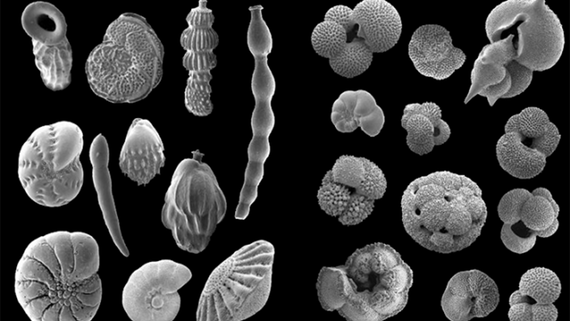Jan 10 2020
During the middle Miocene Climate Optimum period, global temperatures were warmer by 3 to 4 degrees, compared to present average temperatures, analogous to the estimates for the year 2100. The seas were thriving with life and the continents’ positions were just like today.
 Marine microfossil, foraminifera. Image Credit: Cardiff University.
Marine microfossil, foraminifera. Image Credit: Cardiff University.
Geologists have long been puzzled over this period, which took place between 15 and 17 million years ago, because they had attempted to decode the initial cause of the environmental conditions and global warming that existed on Earth later on.
This period of global warming was already known to be accompanied by huge volcanic eruptions, which included a large part of the present Pacific Northwest in the United States, known as the Columbia River flood basalts.
During the same period, a significant oil-rich rock layer, called the Monterey Formation, formed along the California coastline because of the burial of carbon-rich marine life.
To date, researchers had found it difficult to solve the puzzle and provide a feasible explanation for the source of the warmth and the relationship between the higher amounts of carbon burial and the volcanic eruptions.
Our planet has been warm before. We can use ancient fossils to help understand how the climate system works during these times.
Carrie Lear, Professor, School of Earth and Ocean Sciences, Cardiff University
Lear is also the study’s senior researcher.
The researchers utilized the chemistry of marine fossils collected from long sediment cores from the Indian, Atlantic, and Pacific oceans to fingerprint the carbon levels and temperature of the seawater where the ancient creatures previously lived at the time of the middle Miocene Climate Optimum. The study was recently published in the Nature Communications journal.
The researchers’ findings demonstrated that the huge volcanic outbursts that occurred on the Columbia River flood basalts discharged CO2 into the atmosphere and ultimately reduced the pH of the ocean. These events led to a rise in global temperatures, which, in turn, increased the sea levels and flooded huge areas of the continents.
These changes created the perfect conditions to bury huge amounts of carbon caused by the build-up of marine creatures in sediments, and to shift the atmospheric volcanic carbon to the ocean over tens of thousands of years.
The elevated marine productivity and carbon burial helped to remove some of the carbon dioxide from the volcanoes and acted as a negative feedback, mitigating some, but not all, of the climatic effects associated with the outpouring of volcanic CO2.
Dr Sindia Sosdian, Study Lead Author, School of Earth and Ocean Sciences, Cardiff University
Previous large episodes of volcanism across the Earth’s history have been associated with extensive oxygen depletion in the oceans and mass extinctions. But no such episodes occurred in the middle Miocene Climate Optimum.
During the Miocene Climatic Optimum the response of the oceans and climate was remarkably similar to other massive volcanic eruptions in the geological record. The presence of the Antarctic ice sheet and the relatively slow release of carbon however minimized the magnitude of environmental change and the associated consequences on marine life during this event.
Dr Tali Babila, Study Co-Author, School of Ocean and Earth Sciences, University of Southampton
Dr Sosdian, continued, “Thanks to our findings we now have a very clear picture of what was going on over 14 million years ago and this will change the way that scientists look at this period of global warming.”
“We know that our current climate is warming much faster than the Miocene Climatic Optimum so we won’t be able to rely on these slow natural feedbacks to counteract global warming. But this research is still important because it helps us understand how our planet works when it is in a warm mode,” concluded Dr Sosdian.
The joint research involved St. Andrews University (UK), the University of Southampton (UK), and Cardiff University (UK). It is a part of a research project supported by the National Environmental Research Council (NERC).